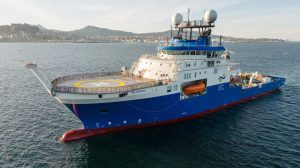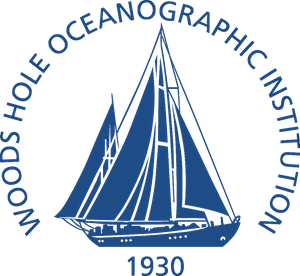From The Woods Hole Oceanographic Institution
5.21.24

Robert Keino (Bosun) assists in recovering the CTD rosette. “CTD” stands for conductivity, temperature, and depth, and refers to a package of electronic devices used to detect how the conductivity and temperature of water changes relative to depth. (Photo by: Alex Ingle, Schmidt Ocean Institute)
A new technology detects trace amounts of oxygen in an environment where previously these life-supporting molecules were below the limit of detection.
Using a new technology called a mini trace analyzer insitu logger, or mTail, an international team of scientists, including Woods Hole Oceanographic Institution’s (WHOI) Maria Pachiadaki, on a Schmidt Ocean Institute expedition has found sporadic pockets of water with trace amounts of oxygen in an area of the Southeast Pacific where oxygen has historically been below the limit of detection. The discovery revises the understanding of microbes and nutrient cycling in a little-studied but important ecosystem, the Oxygen Minimum Zone (OMZ). Traditional oceanographic sampling equipment has been unable to detect oxygen in the core of the Southeast Pacific OMZ, leaving gaps in scientific knowledge on how this globally important ecosystem functions.
Pachiadaki, an associate scientist of biology at WHOI, led the science team on the 34-day expedition, which included scientists from Chile, Spain, Mexico, the United Kingdom, Sweden, and Denmark. The research was conducted onboard Schmidt Ocean Institute’s R/V Falkor (too), where the team deployed several other novel technologies.

The mTail device is a trace oxygen profiler that the scientists attached to a rosette, that carries Niskin bottles, and a mooring, standard pieces of oceanographic research equipment. Drs. Morten Larsen and Bo Thamdrup of the University of Southern Denmark developed the device alongside Dr. Laura Bristow of the University of Gothenburg, Sweden. Traditional sampling equipment for studying oxygen is relatively low-resolution compared to the mTail, resulting in inaccurate oxygen measurements in the OMZ.
OMZs extend from 100 to 1000 meters depth and are considered areas where oxygen concentration is beyond the detection limit for traditional equipment. The scientists’ application of multiple, custom-built technologies specifically designed for the OMZ offers a new paradigm for studying this globally important environment and new insights into how it functions.
“Life started on our planet without oxygen,” said Dr. Osvaldo Ulloa of the Instituto Millenio de Oceangrafíca, Chile, a principal investigator on this expedition, “While no large animals like fish and whales live here, the OMZ is thriving with microbes. This microbial ecosystem is likely the most analogous marine environment to the ancient ocean. By researching these invisible organisms and their ecosystem, we unlock key insights into what our planet likely looked like millions of years ago and how this environment may respond to a changing climate.”
The Southeast Pacific OMZ is a naturally occurring ecosystem off the west coast of South America. The Ocean’s physics and biology create a region with weak ocean circulation and high productivity, resulting in a large quantity of organic matter for microorganisms to consume. OMZs are likely growing due to climate change. Most large animals cannot live permanently in the OMZ due to insufficient oxygen, however, the zone is home to a vast thriving microbial ecosystem. When oxygen is unavailable, microbes use molecules like ammonia and nitrate for energy, releasing nitrous oxide as a byproduct — a greenhouse gas 245 times more potent than carbon dioxide.
“The impacts of finding trace oxygen have potentially far-reaching consequences for the OMZ microorganisms,” said Bristow. “When the oxygen appears, it supplies the microbial community with small but significant amounts of oxygen, which can impact the turnover of greenhouse gases in these systems, reshaping our conceptual understanding of how the oxygen minimum zone actually works.”
To study the microbial activity in the OMZ, the science team used another technology known as a Submersible Incubation Device (SID). The SID is an autonomous laboratory that measures microbial activity in the environment, allowing scientists to measure nutrient cycling under the conditions in which they naturally occur rather than attempting to simulate them back in the lab. The equipment is built with only glass and titanium, preventing oxygen contamination during experimentation. This particular SID was developed through an international collaboration of Drs Bristow, Thamdrup, and Larsen, as well as the lab of Dr. Pachiadaki of WHOI.

Josh O’Brien and Annabelle Adams-Beyea remove Niskin bottles from the CTD rosette prior to a re-deployment. Highly sensitive oxygen sensors were mounted on the CTD rosette which were used to make measurements of the extent of the oxygen minimum zone. (Photo by: Alex Ingle, Schmidt Ocean Institute)
Other cutting-edge technologies tested during the expedition included a HyperPro multi-wavelength optical sensor, and a Pump Profiling System developed by Dr. Ulloa’s lab at the Instituto Millenio de Oceanografíca. These new technologies allowed the team to collect multiple types of data about an ecosystem invisible to the human eye. Data from the expedition will be further analyzed in onshore labs to determine the implications of sensing oxygen in the OMZ core.
“Until now, scientists have been challenged to measure low levels of oxygen in the ocean due to sampling limitations. This expedition was an exciting test of novel technology that pushed a critical boundary of detection and highlights the need for continuing innovation in Ocean research,” said Schmidt Ocean Institute Executive Director Dr. Jyotika Virmani. “The suite of technologies developed by Dr. Pachiadaki and her colleagues open the doors to an increased understanding of microbial processes and phenomenon in these expanding Oxygen Minimum Zones.”
NOTE: The scientists participating in the expedition were awarded ship time onboard R/V Falkor (too) to conduct research. Scientists participating in SOI expeditions are not employed by the Institute.
See the full article here .
Comments are invited and will be appreciated, especially if the reader finds any errors which I can correct.
five-ways-keep-your-child-safe-school-shootings
Please help promote STEM in your local schools.

Mission Statement
The Woods Hole Oceanographic Institution is dedicated to advancing knowledge of the ocean and its connection with the Earth system through a sustained commitment to excellence in science, engineering, and education, and to the application of this knowledge to problems facing society.
Vision & Mission
The ocean is a defining feature of our planet and crucial to life on Earth, yet it remains one of the planet’s last unexplored frontiers. For this reason, WHOI scientists and engineers are committed to understanding all facets of the ocean as well as its complex connections with Earth’s atmosphere, land, ice, seafloor, and life—including humanity. This is essential not only to advance knowledge about our planet, but also to ensure society’s long-term welfare and to help guide human stewardship of the environment. WHOI researchers are also dedicated to training future generations of ocean science leaders, to providing unbiased information that informs public policy and decision-making, and to expanding public awareness about the importance of the global ocean and its resources.
The Institution is organized into six departments, the Cooperative Institute for Climate and Ocean Research, and a marine policy center. Its shore-based facilities are located in the village of Woods Hole, Massachusetts and a mile and a half away on the Quissett Campus. The bulk of the Institution’s funding comes from grants and contracts from the National Science Foundation and other government agencies, augmented by foundations and private donations.
WHOI scientists, engineers, and students collaborate to develop theories, test ideas, build seagoing instruments, and collect data in diverse marine environments. Ships operated by WHOI carry research scientists throughout the world’s oceans. The WHOI fleet includes two large research vessels ( R/V Atlantis and R/V Neil Armstrong); the coastal craft Tioga; small research craft such as the dive-operation work boat Echo; the deep-diving human-occupied submersible Alvin; the tethered, remotely operated vehicle Jason/Medea; and autonomous underwater vehicles such as the REMUS and SeaBED.



WHOI offers graduate and post-doctoral studies in marine science. There are several fellowship and training programs, and graduate degrees are awarded through a joint program with the Massachusetts Institute of Technology. WHOI is accredited by the New England Association of Schools and Colleges . WHOI also offers public outreach programs and informal education through its Exhibit Center and summer tours. The Institution has a volunteer program and a membership program, WHOI Associate.
On October 1, 2020, Peter B. de Menocal became the institution’s eleventh president and director.
History
In 1927, a National Academy of Sciences committee concluded that it was time to “consider the share of the United States of America in a worldwide program of oceanographic research.” The committee’s recommendation for establishing a permanent independent research laboratory on the East Coast to “prosecute oceanography in all its branches” led to the founding in 1930 of the Woods Hole Oceanographic Institution.
A $2.5 million grant from the Rockefeller Foundation supported the summer work of a dozen scientists, construction of a laboratory building and commissioning of a research vessel, the 142-foot (43 m) ketch R/V Atlantis, whose profile still forms the Institution’s logo.
WHOI grew substantially to support significant defense-related research during World War II, and later began a steady growth in staff, research fleet, and scientific stature. From 1950 to 1956, the director was Dr. Edward “Iceberg” Smith, an Arctic explorer, oceanographer and retired Coast Guard rear admiral.
In 1977 the institution appointed the influential oceanographer John Steele as director, and he served until his retirement in 1989.
On 1 September 1985, a joint French-American expedition led by Jean-Louis Michel of IFREMER and Robert Ballard of the Woods Hole Oceanographic Institution identified the location of the wreck of the RMS Titanic which sank off the coast of Newfoundland 15 April 1912.
On 3 April 2011, within a week of resuming of the search operation for Air France Flight 447, a team led by WHOI, operating full ocean depth autonomous underwater vehicles (AUVs) owned by the Waitt Institute discovered, by means of sidescan sonar, a large portion of debris field from flight AF447.
In March 2017 the institution effected an open-access policy to make its research publicly accessible online.
The Institution has maintained a long and controversial business collaboration with the treasure hunter company Odyssey Marine. Likewise, WHOI has participated in the location of the San José galleon in Colombia for the commercial exploitation of the shipwreck by the Government of President Santos and a private company.
In 2019, iDefense reported that China’s hackers had launched cyberattacks on dozens of academic institutions in an attempt to gain information on technology being developed for the United States Navy. Some of the targets included the Woods Hole Oceanographic Institution. The attacks have been underway since at least April 2017.

